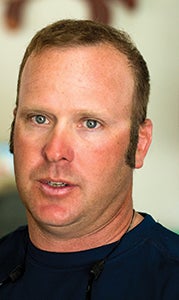Growing pains
Published 1:23 pm Tuesday, May 19, 2015
Soft shell crabs offer a seasonal delight
There’s something special about the month of May in coastal Virginia, and it has nothing to do with dogwoods or azaleas.
As the waters warm in the Chesapeake Bay and the tidal rivers that feed it, a grand awakening begins, followed by an even grander transformation. The awakening happens below the surface and goes largely unseen, but Ben Johnson and the other employees of Johnson and Sons Seafood in Eclipse will see the transformation take place thousands of times between now and November.
With the water temperature topping 50 degrees now — and likely to stay that way until sometime in November — Virginia’s blue crabs are awake, moving about and growing.

Ben Johnson originally planned to be an accountant. But a few twists and a suggestion from his waterman father changed all that. Today he works with his father harvesting and selling crabs and oysters from their Eclipse docks.
It’s the growing part that Johnson gets to watch.
He has thoughtfully placed crab pots in the James River, and for crabs losing their hard shells in the molting process, those wire enclosures appear to offer excellent protection from predators for the duration of the molt. The safety is, of course, an illusion, as Johnson checks the traps daily, hauling in hundreds of peeler crabs per day during the peak of the season.
Those crabs are hauled to the Johnsons’ dock in Eclipse, and they’re unloaded into tanks, where the water is continuously recycled from adjacent Chuckatuck Creek. For the next six months, someone will be watching these tanks almost 24 hours a day, waiting for the crabs to back out of their hard shells and transform into one of Virginia’s most eagerly anticipated seasonal delicacies: the soft shell crab.
“It’s a significant commitment, because they always, always have got to be tended to,” Johnson says, looking over the operation inside a dockside building strung with bare-bulbed lights and lined with 28 tanks stacked more than six feet high. On the second day of soft shell season, only about a third of those tanks are running.
“When things are full, it’s pretty much constant” work for whoever is on duty moving “busters” — those crabs whose shells have cracked and started to slough off — from the peeler tanks and into safer ones where they won’t be hurt, and then moving the soft shells from the tanks and into a cold room to await shipping to a distributor or dockside purchase by individuals and restaurants willing to pick the crabs up themselves.
For all his hard work, Johnson doesn’t even eat soft shell crabs. After having enjoyed them all his life, he had some at dinner one evening several years ago and awoke that night with hives. A year or so later, he tried again, and the hives returned, but worse.
“I can eat crab cakes, crab meat — all that stuff,” he says. But not soft shells, the crabs he works hardest to harvest. “The only thing I can think is it’s something in the shell.”
Actually, for those folks in Tidewater who love crabs and suffer no allergic reactions, it’s well known that Virginia’s blue crabs are, indeed, something in the shell. But the secret that even some crab lovers haven’t discovered is that blue crabs are something wonderful out of the shell.







